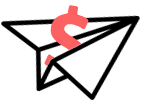Freelancing is a great way to make a living. You get to spend your career working on interesting and rewarding projects, working flexible hours and having the freedom to live and work where you choose.
All those are fantastic benefits. But an even greater advantage of freelancing is that you can make very good money, and it can happen very fast.
That is certainly not true of many solopreneur business models. If you decide to become a blogger, for example, you can expect perhaps a year of effort before you start making a decent income.

Get Weekly Freelance Gigs via Email
Enter your freelancing address and we'll send you a FREE curated list of freelance jobs in your top category every week.
Other businesses – such as ecommerce startups – may require you to invest lots of money upfront, in the hope of making money further down the track.
There are few options that offer a real chance to start from scratch with no money and build a six-figure income in 12 months. Fortunately, freelancing is one of them.
I know that for sure, because that is exactly how I launched my career as an entrepreneur back in the 1990s.
A lot has changed since I started freelancing, but many things have stayed the same. The technology we use to do business has transformed beyond anything we could have imagined back then.
Yet the basics of winning high-paying gigs have changed little. The only difference is that making it happen is so much easier now.
So if you want to create a six-figure income in the next 12 months, my story will provide you with strategies you can apply today to accelerate your success. Here’s how I did it:
1. Choosing the right freelance niche
The foundations for my rapid success as a freelancer were actually laid while I was still a full-time employee. In those years, I made a few choices that set me up for higher-earnings in my freelance writing career.
I had known from a young age that I wanted to be a writer, despite my family’s insistence that writing was not a ‘proper job,’ and I should study something sensible – like engineering.
After a few twists in my early career, I studied Journalism at what is now the London University of the Arts, then started working my way up the journalism ladder.
But I soon learned that most journalists don’t make much money, whereas writers in the corporate world do very well as writers. So I jumped at the chance to become the editor of an enterprise magazine and doubled my income overnight.
I considered that to be a big improvement – until I met the agency copywriters working on the company’s ad account. They showed me that the real money for writers was in advertising and marketing.
After a while I joined the agency as a copywriter and learned the craft of writing copy that sells.
Once I had a couple of years’ experience under my belt, I decided it was time to go freelance. And because I had shifted from lowly-paid journalism to the high-dollar world of advertising, I was in a position to charge high rates and achieve success quickly.
Takeaway #1
Figure out how you can offer the most value to potential clients. Journalists are two-a-penny. Editors generally view their work as a commodity to be purchased at the lowest possible price.

Copywriters, on the other hand, can deliver massive value. A good ad campaign can generate millions of dollars in sales, so it’s easy to justify paying high rates to writers who can deliver copy that sells.
Whatever kind of work you do, you will make more money if you focus on the areas where you deliver the greatest outcomes for your clients.
2. Looking professional
Once I had quit my job, I needed to find my first clients in a hurry. I had a young family to support, and a big-city mortgage to cover every month. So I went into full-on marketing mode.
And the first step of the marketing campaign was to create the right impression. If you want to charge professional rates, you need to present yourself in a professional way.
In the pre-Internet days of the 90s, face-to-face meetings with clients were a necessity if you wanted to win freelance work.
Yet, many of the freelancers I knew considered them to be creatives who could get away with a Bohemian approach.

Not me. I wore jeans and T-shirts at home, but for meetings I dressed in expensive suits and presented quality business cards. I had a website and an email address when most freelancers had no idea what the Internet was.
I also invested in a brick-sized cell phone that cost a fortune. Clients loved knowing they could reach me even while I was traveling…a real novelty in those days.
The upshot of all this is that clients trusted me to act professionally, and they knew they could contact me easily to get the job done.
While my ‘creative’ freelance pals were struggling to find clients – even at dismal pay rates – I started picking up great clients who paid good rates for quality work.
Takeaway #2
In today’s world, technology has made face-to-face meetings less important, but presentation is still critical. Look more professional than your competitors by:
- Building a high-quality website that showcases your work
- Responding promptly to requests for information, etc.
- Using a scheduling app to help clients set appointments
- Having an impressive presence on LinkedIn
- Presenting yourself as a professional who deserves proper compensation
3. Finding clients
If you want to make a six-figure income as a freelancer, you need a solid system for getting freelance clients.

Most importantly, you need to escape the boom-bust cycle that dooms most freelancers to an endless stream of unprofitable. This is what happens…
After doing some lead generation, you land a client with a major project. So you immediately stop marketing and focus on doing the job in hand. But when that job finishes, you now have nothing in your pipeline.
So with end-of-month bills looming, you are desperate for work. You grab at the next project that comes along, even if the pay is mediocre. And now you are trapped in the low-pay cycle.
To avoid that problem, I hired a part-time assistant whose sole job was to do outreach to potential clients. No matter how busy I was with current projects, she was continuously starting conversations with potential clients.
This meant I always had new prospects on the horizon, so I never felt the need to compromise on rates.
If someone tried to negotiate a lower fee, I would politely pass them along to my freelance friends who were desperate for work.
In those days, outreach meant old-fashioned direct mail and cold calling, so it was hard work. Today, you can get the same results far more efficiently using LinkedIn prospecting and email outreach.
Takeaway #3
You need to think of yourself as a business professional first, not as a creative. Ongoing marketing is critical to generating a consistent pipeline of leads. Even if you have a very limited budget, there are ways to bring in a steady stream of freelance business leads.
4. Selecting clients carefully
Even though my background was in advertising, I never ran ads to attract clients. I preferred to use outreach because it gave me control over my prospect pool.
I drew up a list of the top 1000 hi-tech and financial companies in London (and their ad agencies). Then my assistant set to work finding and reaching out to senior decision-makers at these corporations.
This way, I was able to attract clients who had big budgets to spend. Negotiating a high rate is much easier when your entire fee represents a tiny dent in the company’s marketing budget.
Going high into the organization chart helps, too.
A junior manager might balk at a $20,000 fee, while the VP of Marketing (who thinks in much bigger numbers) may consider it a bargain.
Takeaway #4
Select the clients that you truly want to work with. Identify prospects who have big budgets to spend on the kind of work you do, plus a recurring need to hire freelance talent. Everything becomes easier when you align yourself with top-drawer clients.
5. Managing projects efficiently
Agreeing on the terms for a project is only half the battle. I soon learned you must ensure that the client sticks to them. After being burned a few times, I got really good at stamping out ‘scope creep.’
Scope creep happens when a client changes the objectives of a project while it is underway. Projects tend to expand, you may find yourself expected to do more work than originally anticipated.
The first few times this happened, I absorbed the additional workload in order to keep the client happy. But it soon became clear that this approach was a ticket to the poor house.
I very quickly learned to agree the terms of the contract up front, and charge for additional work at an agreed rate…no exceptions allowed.
Takeaway #5
Be aware that scope creep is going to happen, and tackle it head on. Agree in advance how projects will be handled, and charge accordingly.
6. Offering complete solutions
The next step forward was to take problems off my customer’s hands. As a freelance writer, I was completing only one part of the puzzle. For most projects, the client had to coordinate a team of people.
I knew many freelance art directors, graphic designers, print managers, video producers and other creative professionals. So I added value by creating teams as and when they were needed.
Clients soon learned that a single call to me could set a whole team in motion. That took a lot of work off their plates, and made me the ‘go to’ guy for getting things done.
For my trouble, I was able to add a markup of 20% to the billings of team members. On larger projects, this added up to a nice chunk of change for very little extra work.
Takeaway #6
Remember that clients are individuals with too much to do, and too little time to do it in. If you can take some responsibility off their plate, they will reward you with additional work.
7. Delivering on time, every time
Creative professionals are often perfectionists who want to deliver work that is not just good, but amazing. While that is a very valid goal, freelancers need to respect deadlines more than anything else.
One early client landed in my lap because another freelancer had let the client down. The freelancer was supposed to deliver finished copy on Friday, but she wasn’t happy with what she had written.
So instead of delivering the copy on time, she spent the weekend working on a new angle.
What she didn’t know was this project was going to press on Saturday morning. And as she hadn’t invested in a brick-style phone, no-one could contact her to chase the copy.
Because she failed to deliver, it could not be printed—with all kinds of consequences. The copywriter was fired, and I got the work instead.
You can be sure that I met all the deadlines I was given, regardless of other considerations. As a result, I got regular work from that client for the next 10 years.
Takeaway #7
As a freelancer, you have to take deadlines seriously. Don’t leave work until the last minute…start early and give yourself plenty of time to do a good job.
8. Moving up the value chain
The next important step forward was realizing that all clients are not equal. I found that some are:
- Easy to work with
- Prepared to pay fair compensation
- Prompt in settling invoices
- Professional in their approach
- Reasonable in their expectations
Those are the ‘golden clients’ that you need to hang on to. But I also found myself working with individuals who were:
- Always looking to cut corners and reduce costs
- Consistently late making payments
- Regularly demanding ‘miracle’ results
- Disorganized or even downright rude
- A pain in the neck to work with
My accountant gave me the best business advice I have ever received—fire the worst 10% of your clients and replace them with better ones.’ This turned out to be a fantastic plan.
I was able to rid myself of the clients that drained lots of time for little reward, and replace them with clients I loved to work with. And my net profits boomed.
Takeaway #8
Always aim to be moving up the value chain, replacing mediocre clients with high-quality people who respect what you do.
9. Asking for referrals
When I was launching my freelance career, I had a friend who was a very successful door-to-door salesman. This seemed surprising to me, as he was a very quiet and gentle man…not the stereotypical salesman at all.
When I asked him the secret of his success, he answered me in a single word—referrals!
Following his guidance, I started asking each of my clients for referrals to three other people who could benefit from my help. Where possible, I persuaded the client to call these people and introduce me.
This put a rocketship under my sales pipeline. I was able to gain access to senior executives I could never have reached otherwise, and many new opportunities opened up.
Takeaway #9
Don’t be afraid to ask your clients for referrals, as well as testimonials and LinkedIn recommendations. They represent the lowest-cost, yet most effective means of bringing in high-value clients.
Why stop at six figures?
Using the strategies outlined above, I was able to reach a six-figure income in my first year of freelancing. Today, that goal is even more attainable, thanks to the amazing tools and connectivity available in the 21st century.
So if you want to create a six-figure income, you can make it happen.
But why stop there? There are many freelancers who earn a seven-figure income…so you can, too. The sky really is the limit in today’s amazing business world.
So set your sights high, freelance like a pro and set yourself on the road to a whole new level of success.
Keep the conversation going...
Over 10,000 of us are having daily conversations over in our free Facebook group and we'd love to see you there. Join us!



